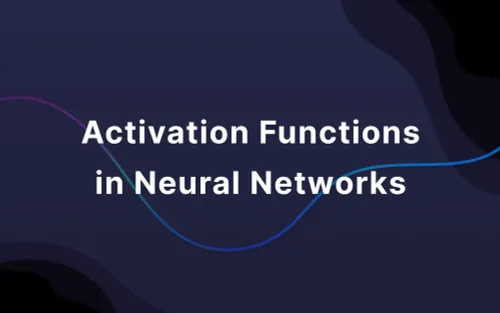Empowering Neural Networks: The Art and Science of Activation Functions
 Saurabh Naik
Saurabh Naik
Introduction:
Deep learning, the cornerstone of artificial intelligence, relies on complex neural networks to unravel patterns and make sense of vast datasets. At the heart of these networks lies a critical element called the activation function. In this blog post, we will embark on a journey to demystify activation functions, exploring their necessity, properties, and significance in the realm of deep learning.
1. What is Activation Function:
Before delving into the intricacies, let's establish a fundamental understanding of what an activation function is. In the context of neural networks, an activation function determines the output of a node or neuron. It introduces non-linearity to the network, allowing it to learn from data that may not follow linear patterns. Essentially, an activation function decides whether a neuron should be activated or not based on its input.
2. Need of Activation Function:
The need for activation functions arises from the inherent limitation of linear transformations. Stacking multiple linear operations results in an overall linear transformation, rendering deep neural networks unable to capture complex, non-linear relationships within data. Activation functions inject non-linearity, enabling neural networks to model intricate relationships and extract meaningful features from data.
3. Properties of an Ideal Activation Function:
a. Non-linearity:
An ideal activation function must be non-linear. Linearity would defeat the purpose, as the entire network would collapse into a linear transformation, losing its ability to learn complex patterns.
b. Differentiability:
Differentiability is crucial for backpropagation, the algorithm responsible for updating the weights of a neural network during training. A differentiable activation function ensures efficient learning and optimization.
c. Zero-centered:
A zero-centered activation function simplifies the learning process by ensuring that positive and negative values are equally considered. This property aids in convergence during optimization.
d. Computationally Inexpensive:
The computational cost of evaluating the activation function should be reasonable. This ensures that the training process is efficient and scalable, particularly in large neural networks.
e. Unsaturated:
An unsaturated activation function avoids reaching extreme values for its inputs. This prevents the network from slowing down during training and helps maintain a healthy flow of information.
Conclusion:
In conclusion, activation functions play a pivotal role in the success of deep learning models. Their non-linear nature empowers neural networks to capture intricate patterns within data, making them indispensable in the era of complex AI applications. As we continue to push the boundaries of artificial intelligence, a nuanced understanding of activation functions will undoubtedly contribute to the evolution of more robust and efficient neural networks.
Subscribe to my newsletter
Read articles from Saurabh Naik directly inside your inbox. Subscribe to the newsletter, and don't miss out.
Written by

Saurabh Naik
Saurabh Naik
🚀 Passionate Data Enthusiast and Problem Solver 🤖 🎓 Education: Bachelor's in Engineering (Information Technology), Vidyalankar Institute of Technology, Mumbai (2021) 👨💻 Professional Experience: Over 2 years in startups and MNCs, honing skills in Data Science, Data Engineering, and problem-solving. Worked with cutting-edge technologies and libraries: Keras, PyTorch, sci-kit learn, DVC, MLflow, OpenAI, Hugging Face, Tensorflow. Proficient in SQL and NoSQL databases: MySQL, Postgres, Cassandra. 📈 Skills Highlights: Data Science: Statistics, Machine Learning, Deep Learning, NLP, Generative AI, Data Analysis, MLOps. Tools & Technologies: Python (modular coding), Git & GitHub, Data Pipelining & Analysis, AWS (Lambda, SQS, Sagemaker, CodePipeline, EC2, ECR, API Gateway), Apache Airflow. Flask, Django and streamlit web frameworks for python. Soft Skills: Critical Thinking, Analytical Problem-solving, Communication, English Proficiency. 💡 Initiatives: Passionate about community engagement; sharing knowledge through accessible technical blogs and linkedin posts. Completed Data Scientist internships at WebEmps and iNeuron Intelligence Pvt Ltd and Ungray Pvt Ltd. successfully. 🌏 Next Chapter: Pursuing a career in Data Science, with a keen interest in broadening horizons through international opportunities. Currently relocating to Australia, eligible for relevant work visas & residence, working with a licensed immigration adviser and actively exploring new opportunities & interviews. 🔗 Let's Connect! Open to collaborations, discussions, and the exciting challenges that data-driven opportunities bring. Reach out for a conversation on Data Science, technology, or potential collaborations! Email: naiksaurabhd@gmail.com